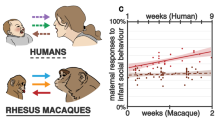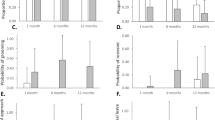Abstract
In this study on Java macaques themain characteristics of the mother-infant relationship during infants' first 10 days have been elaborated. Early mother and infant behaviour is described and early interactions between mothers and their young have been analyzed. Observations and trend analyses of early behaviours like ventro-ventral contact behaviour, being on nipple, and explorative behaviour, make it clear that Java macaque infants play an important role in the early development of mother-infant interactions. In contrast to the rhesus and the stumptailed infant, the young Java macaque appears to develop a great variety of behaviours in its first 10 days. Whereas the infant's behaviour gains in complexity and social initiative, the mother becomes increasingly more passive and self-oriented. Early mother-infant interaction can be characterized by mutual adjustment.
Similar content being viewed by others
References
Altmann, J., 1980.Baboon Mothers and Infants. Harvard Univ. Press, Cambridge & Massachusetts.
Berman, C. M., 1982. The ontogeny of social relationships with group companions among freeranging infant rhesus monkeys. 1. Social networks and differentiation.Anim. Behav., 30: 149–162.
Bobbitt, R. A., G. D. Jensen, &B. N. Gordon, 1964. Behavioural elements (taxonomy) for observing mother-infant-peer interaction inMacaca nemes rina.Primates, 5: 71–80.
Capitanio, J. P., 1984. Early experience and social processes in rhesus macaques (Macaca mulatta). 1. Dyadic social interaction.J. Comp. Psychol., 98: 35–44.
Chalmers, N. R., 1972. Comparative aspects of early infant development in some captive Cercopithecines. In:Primate Socialization,F. E. Poirier (ed.), Random House, New York, pp. 63–82.
Chance, M. R., E. Jones, &S. Shostak, 1977. Factors influencing nursing inMacaca fascicularis.Folia Primatol., 27: 28–40.
Chevalier-Skolnikoff, S., 1974.The Ontogeny of Communication in the Stumptail Macaque (Macaca arctoides). Contributions to Primatology, Vol. 2. Karger, Basel.
Dienske, H. &H. A. J. Metz, 1977. Mother-infant body contact in macaques: a time interval analysis.Biol. Behav., 2: 3–38.
Finn, J. D., 1977. Multivariance, univariate and multivariate analysis of variance, covariance, regression and repeated measures. A fortran IV program, version VI. National Educational Resources, Chicago.
Gubernick, D. J., 1981. Parent and infant attachment in mammals. In:Parental Care in Mammals,D. J. Gubernick &P. Klopfer (eds.), Plenum Press, New York & London, pp. 243–307.
Hansen, E. W., 1966. The development of maternal and infant behavior in the rhesus monkey.Behaviour, 27: 107–149.
Harlow, H. F. &M. K. Harlow, 1965. The affectional systems. In:Behavior of Non-human Primates, Vol. 2,A. M. Schrier,H. F. Harlow, &F. Stollnitz (eds.), Academic Press, New York & London, pp. 287–335.
————, ————, &E. W. Hansen, 1963. The maternal affectional system of rhesus monkeys. In:Maternal Behavior in Mammals,H. L. Rheingold (ed.), John Wiley, New York, pp. 254–281.
Harrington, J. E., 1978. Development of behavior inLemur macaco in the first nineteen weeks.Folia Primatol., 29: 107–128.
Hauser, M. D., 1986. Parent-offspring conflict: care elicitation behaviour and the ‘cry-wolf’ syndrome. In:Primate Ontogeny, Cognition and Social Behaviour,J. G. Else &P. C. Lee (eds.), Cambridge Univ. Press, Cambridge, pp. 193–204.
Hinde, R. A., 1969. Analyzing the roles of the partners in a behavioral interaction, mother-infant relations in rhesus-macaques.Ann. New York Acad. Sci., 159: 651–667.
————, 1974. Mother/infant relations in rhesus monkeys. In:Ethology and Psychiatry: From the Clarence M. Hincks Memorial Lectures Held at McMaster University,N. F. White (ed.), Univ. of Toronto Press, Canada, pp. 29–47.
———— &S. Atkinson, 1970. Assessing the roles of social partners in maintaining mutual proximity, as exemplified by mother-infant relations in rhesus monkeys.Anim. Behav., 18: 169–176.
———— &Y. Spencer-Booth, 1968. The study of mother-infant interaction in captive group-living rhesus monkeys.Proc Roy. Soc. B., 169: 177–201.
———— &L. E. White, 1974. Dynamics of a relationship: rhesus mother-infant ventro-ventral contact.J. Comp. Phys. Psychol., 86: 8–23.
Jensen, G. D., R. A. Bobbitt, &B. N. Gordon, 1968. Effects of the environment on the relationship between mother and infant pigtailed monkeys (Macaca nemestrina).J. Comp. Phys. Psychol., 66: 259–263.
————, ————, & ————, 1973. Mothers' and infants' roles in the development of independence ofMacaca nemestrina.Primates, 14: 79–88.
———— &B. N. Gordon, 1975. Leaving and approaching behavior in mother and infant monkeysMacaca nemestrina, a sequence analysis. In:Proceedings of the Fifth International Congress of Primatology, Nagoya, Japan, Contemporary Primatology,S. Kondo,M. Kawai, &A. Ehara (eds.), Karger, Basel, pp. 326–333.
————, ————, &J. Wolfheim, 1975. Nursing behavior in infant monkeys: a sequence analysis.Behaviour, 55: 115–128.
Kaufman, I. C. &L. A. Rosenblum, 1966. A behavioral taxonomy forM. nemestrina andM. radiata: based on longitudinal observations of family groups in the laboratory.Primates, 7: 205–258.
———— & ————, 1969. The weaning of the mother-infant bond in two species of macaque. In:Determinants of Infant Behaviour IV,B. M. Foss (ed.), Methuen, London, pp. 41–60.
Kemps, A. &P. Timmermans, 1982. Parturition behaviour in pluriparous Java-macaques (Macaca fascicularis).Primates, 23: 75–88.
Murray, R. D. &K. M. Murdoch, 1977. Mother-infant dyad behavior in the Oregon troop of Japanese macaques.Primates, 18: 815–824.
Nash, L. T., 1978. The development of the mother-infant relationship in wild baboons (Papio anubis).Anim. Behav., 26: 746–759.
Nicolson, N. A., 1987. Infants, mothers, and other females. In:Primate Societies,B. B. Smuts,D. L. Cheney,R. M. Seyfarth,R. W. Wrangham, &T. T. Struhsaker (eds.), The Univ. of Chicago Press, Chicago & London, pp. 330–343.
Plooy, F. X., 1980. The behavioural development of free-living chimpanzee babies and infants. Dissertation, Univ. of Groningen, The Netherlands.
Rosenblum, L. A., 1971. Infant attachment in monkeys. In:The Origins of Human Social Relations,H. R. Schaffer (ed.), Academic Press, New York, pp. 85–113.
Simpson, M. J. A., A. E. Simpson, &S. Howe, 1986. Changes in the rhesus mother-infant relationship through the first four months of life.Anim. Behav., 34: 1528–1539.
Sussman, R. W. &I. Tattersall, 1981. Behavior and ecology ofMacaca fascicularis in Mauritius: a preliminary study.Primates, 22: 192–205.
Swartz, K. B. &L. A. Rosenblum, 1981. The social context of parental behavior: a perspective on primate socialization. In:Parental Care in Mammals,D. J. Gubernick &P. Klopfer (eds.), Plenum Press, New York & London, pp. 417–455.
Author information
Authors and Affiliations
About this article
Cite this article
Kemps, A., Timmermans, P. & Vossen, J. Developmental trends in mother-infant interactions in Java macaques (Macaca fascicularis) during the first ten days of life. Primates 31, 65–77 (1990). https://doi.org/10.1007/BF02381030
Received:
Accepted:
Issue Date:
DOI: https://doi.org/10.1007/BF02381030




